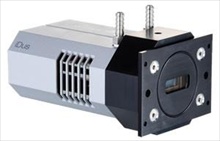Members Login

Channels
Special Offers & Promotions
1,000-fold Response Increase shown in Nanoantenna Arrays
 Nanoscale
antennas hold out the promise of higher resolution optical imaging of nano
objects, including proteins and DNA molecules, and converting solar energy into
electricity at very high efficiencies. Now, a team from the University of
Illinois led by Nicholas Fang and Kimani Toussaint has demonstrated a
1,000-fold increase in the UV-Visible optical response of devices based on
nanoantennas periodic arrays.
Nanoscale
antennas hold out the promise of higher resolution optical imaging of nano
objects, including proteins and DNA molecules, and converting solar energy into
electricity at very high efficiencies. Now, a team from the University of
Illinois led by Nicholas Fang and Kimani Toussaint has demonstrated a
1,000-fold increase in the UV-Visible optical response of devices based on
nanoantennas periodic arrays.First proposed by Robert L. Bailey in 1972, nanoantennas are analogous to radio and microwave antennas, except that they can absorb a specific range of wavelengths of light dependant on their geometry and size. Bowtie NanoAntennas consist of two triangular pieces of gold with their tips facing each other in the shape of a miniature bowtie. They take energy from the illuminating beam and compress it into the nanometre gap separating the two triangles. The result is a concentrated spot of light that is many times more intense than the incoming laser beam.
Fang and Toussaint's team fabricated 50 nm thick gold Bowtie NanoAntenna (BNA) composed of two equilateral triangles with 140 nm sides separated by a 20 nm gap and acquired the emission spectra when illuminated with 780 nm laser light using an Andor iDus DU420A-BU camera. When individual antennas were gathered into arrays with 500 nm centre-to-centre spacing, they found that the large local intensity enhancement of the single BNA was boosted by a factor of 1,000. More importantly, resonantly excited arrays exhibited uniform emission over a spectral region of more than 250 nm. The team believes that optimisation of the nanoantenna array periodicity may lead to even further efficient devices.
Recent studies have also suggested the possible development of nanoantenna-based solar energy collection devices with conversion efficiency up to 80 % - compared to 20% for traditional solar cells - as well as the use of nanoantennas arrays as nanoscale light sources to scan and image biological molecules or synthetic nano-objects such as carbon nanotube bundles.
Antoine Varagnat, Product Specialist at Andor, commented that "NanoAntennas have come under greater scrutiny over the last few years, due to their potential to provide nanoscale, cost-effective optical probing or high-efficiency collection devices. Andor's iDus CCD platform is ideally suited to the study of the key mechanisms at the origin of nanoantennas unique properties, namely nonlinear Second Harmonic Generation (SHG) and complex photoluminescence. iDus' high UV to Near-Infrared response, ultra low noise and high dynamic range allow the analysis of a wide range of intensities of these broadband phenomena, providing the accurate information essential to the fine-tuning and optimization of the amplification properties of these nanoantennas. And iDus "BU" UV-enhanced back-illuminated CCD was just the right choice for the team's 350 to 660 nm detection requirement."
Andor's modular Spectroscopy solutions encompass a wide range of high performance CCD, ICCD and EMCCD detectors, as well as a comprehensive range of Research-grade spectrograph platforms. To learn more about the iDus camera series and their use in spectroscopy, please visit the spectroscopy section of the Andor website at www.andor.com/spectroscopy_solutions.
Reference
Kaspar D. Ko, Anil Kumar, Kin Hung Fung, Raghu Ambekar, Gang Logan Liu, Nicholas X. Fang, and Kimani C. Toussaint, Jr. "Nonlinear Optical Response from Arrays of Au Bowtie NanoAntennas," Nano Lett. 2011, 11, 61-65
About Andor Technology
Andor is a world leader in Scientific Imaging, Spectroscopy Solutions and Microscopy Systems. Established in 1989 from Queen's University in Belfast, Northern Ireland, Andor Technology now employs over 300 people in 16 offices worldwide, distributing its portfolio of over 80 products to 10,000 customers in 55 countries.
Using the latest cutting edge technologies, Andor designs and manufactures robust, high performance instruments allowing scientists around the world to measure light down to a single photon and capture events occurring within 1 billionth of a second. This unique capability is helping them push back the boundaries of knowledge from nano-scale to universe-scale level in fields as diverse as drug discovery, new material development and analysis, medical diagnosis, food quality control, art restoration, astronomy and solar energy research.
More information about Andor Technology PLC (LSE: AND) is available at the company's website (www.andor.com).
Media Partners


